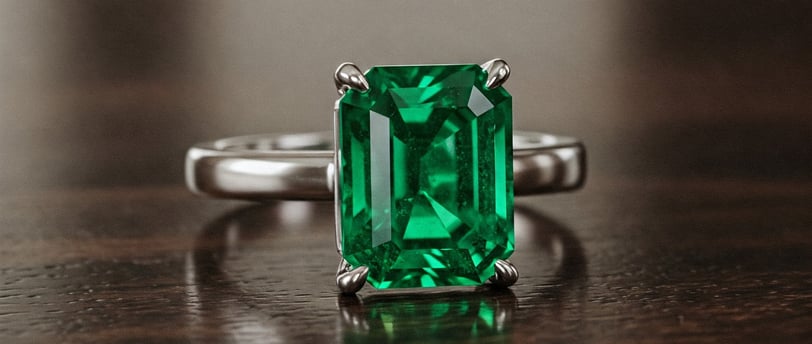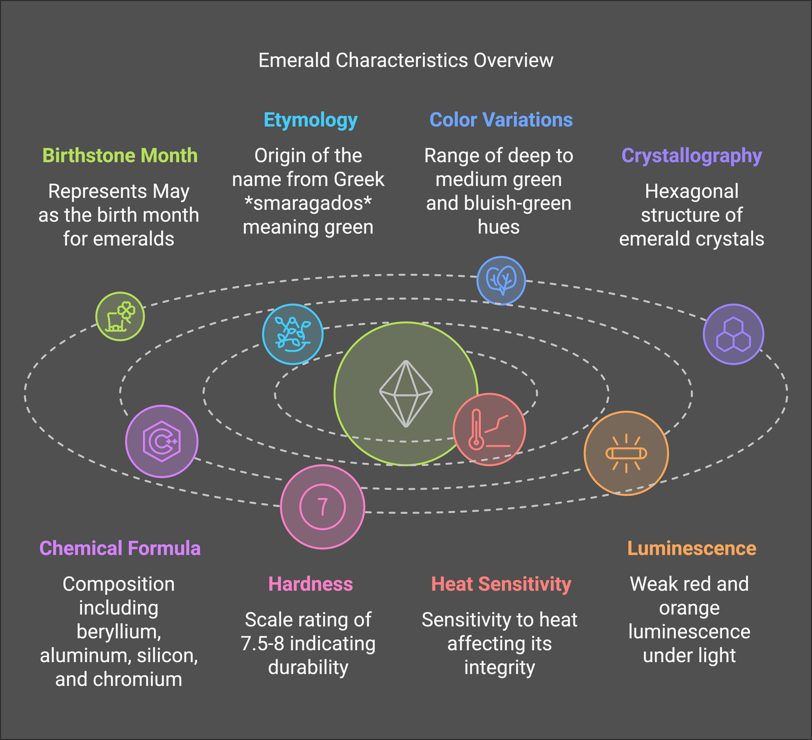Emerald
Discover the captivating world of emeralds: their history, unique qualities, and essential buying and care tips. Learn how to make informed choices about this precious green gemstone and its place in your collection.
1/30/20254 min read


History
Emeralds have captivated people for millennia, holding a place of reverence in various cultures. The ancient Egyptians, including Cleopatra, were known for their passion for emeralds. The Incas and Aztecs also honored emeralds, using them in religious ceremonies. The allure of emeralds persists today, making them a highly sought-after gemstone. Emeralds are also the birthstone for May, and the gemstone associated with the 20th and 35th wedding anniversaries.
Mineral Origins
Emerald is a variety of the mineral beryl, which also includes aquamarine. The green colour of emeralds is due to trace amounts of chromium or vanadium, and sometimes iron, within the beryl crystal. Geological conditions in various locations give rise to unique characteristics in the emeralds found there. Colombia is a major source of emeralds, with the Muzo mine known for its superior colour. Other notable sources include Brazil, Zambia, and Zimbabwe. Zambian emeralds are often a deep, mysterious green, while Zimbabwean emeralds possess an intense hue, though they are typically smaller.
The 4 C’s
Like other gemstones, the value of an emerald is determined by a combination of factors, often referred to as the 4 Cs: colour, clarity, carat, and cut.
Colour
Colour is the most crucial factor in determining the value of an emerald. The most desirable emerald colours range from a bluish green to a pure green, with a vivid saturation and a tone that is not too dark. Secondary hues of blue can enhance the perceived richness of a gem, while yellow hues are generally less sought after. Slight variations in hue can significantly impact the price of an emerald. Colombian emeralds are famed for their warmer, more intense pure green colour, while Zambian emeralds are said to have a cooler, more bluish-green colour. However, colour can vary within different mines of the same region.
Clarity
Unlike other gemstones, emeralds are known for their inclusions, which are often described as looking mossy or garden-like and are called "jardin". The Gemological Institute of America (GIA) classifies emeralds as a "Type III" gemstone, meaning that eye-clean stones are extremely rare. While stones with fewer inclusions are more valuable, a deep, full colour in an emerald is more valuable than a flawless stone with a pale colour. Some collectors prefer stones with jardin as proof of authenticity. Colourless inclusions are preferable to black ones.
Carat
As with many gemstones, the price per carat of an emerald increases with size. However, the price depends more on the quality of the stone, with exceptional gems commanding a much higher price per carat. Emeralds appear larger than diamonds of the same carat weight due to their lower density. Emeralds come in a range of sizes, with some in museums weighing hundreds of carats.
Cut
The most popular cut for emeralds is the emerald cut, which is a rectangular or square step cut. This shape enhances the crystal's natural colour while minimising wasted rough. The cutter must take into account the rough's depth of colour, durability, and inclusions when making cutting decisions. An emerald with a light tone may take a deeper cut to enhance the colour, while a dark specimen may take a shallower cut. Other cuts, such as rounds or ovals, are also possible, but require cutting away more rough material.
Be Aware of
Enhancements
Most emeralds undergo treatments to improve their appearance, typically involving filling cracks and fissures with oil, resin, or a polymer. These treatments may need to be reapplied over time. The GIA has a scale to classify the level of clarity enhancement as minor, moderate or significant. The level of treatment affects the price of the emerald. Some emeralds may also have colour-enhancing treatments, but these may deteriorate over time.
Simulants
Be wary of green gemstones that may be sold as emeralds, such as green sapphire, often called “oriental emeralds”. True, natural emeralds will not have descriptive qualifiers in their names. Simulants can include glass, yttrium aluminum garnet (YAG), green cubic zirconia (CZ), assembled triplets of beryl and synthetic spinel. It is always recommended to obtain a report for an emerald from an independent gemological laboratory to verify authenticity.
Synthetics
Lab-grown emeralds are chemically the same as natural emeralds and often offer better quality for the price, with fewer inclusions. They do not require treatments to improve clarity and are less susceptible to cracking. Synthetic emeralds are produced using either the hydrothermal or flux methods. These methods involve costly equipment and energy, which accounts for their relatively high price compared to other synthetics. Synthetic emeralds may have different inclusions from natural emeralds.
Final Thoughts
Buying Tips
When buying an emerald, it is important to consider the 4 Cs: colour, clarity, carat, and cut. Look for a vivid, slightly bluish green with a medium-dark tone. Be aware of enhancements and obtain a report from a gemological lab. Consider lab-created emeralds as an ethical and more affordable alternative. The most important thing is to examine the stone in person.
Jewelry Care
Emeralds are brittle and subject to cracking due to their jardin. Avoid mechanical cleaning methods, like ultrasonic cleaners. Clean emeralds with a soft brush, mild detergent and warm water. Emerald rings should have protective settings. Emeralds are excellent choices for pendants, brooches and earrings.


Gemius Stones
Expertise
© 2025. All rights reserved.
